Analyzing the Economic Implications of Tuition-Free Two-Year Colleges
VerifiedAdded on 2022/08/18
|7
|1948
|223
Essay
AI Summary
This essay, written by a student, examines the economic pros and cons of making two-year colleges tuition-free. It begins by outlining the proposal for free community college and its potential benefits, such as increased access to education, reduced student debt, and improved job opportunities. The essay then addresses counterarguments, including concerns about student motivation, potential economic costs to taxpayers, and the impact on the economy. It incorporates data and research from various sources to support its claims, including studies on enrollment rates and graduation success. The author argues that free community college can provide equal opportunities, improve the economy through a more educated workforce, and reduce the financial burden on students and families. The essay also considers the views of different generations and the importance of designing tuition-free college policies that are fair and accessible to all. The student concludes that the government should support two-year colleges becoming tuition-free to create an equal opportunity for all students.
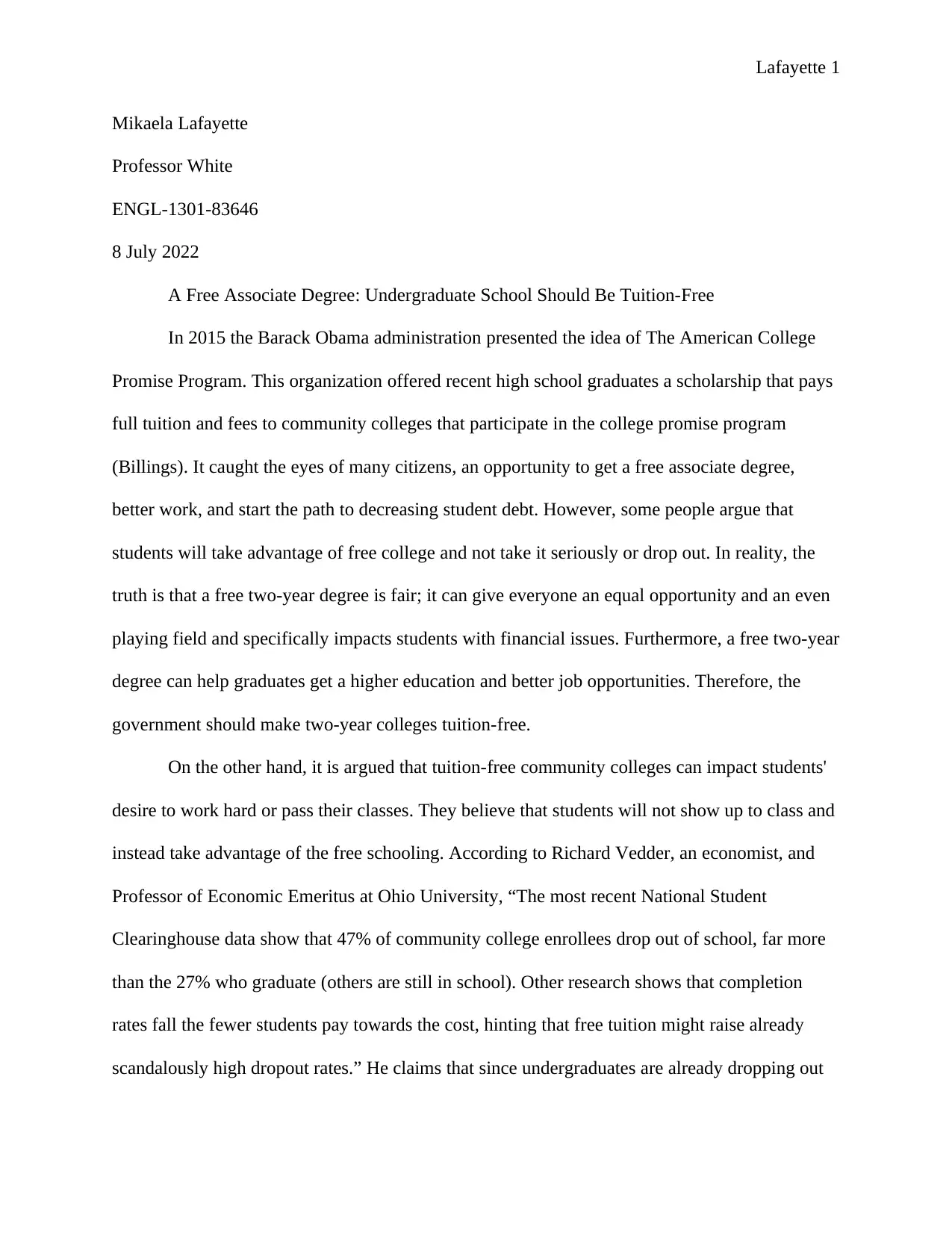
Lafayette 1
Mikaela Lafayette
Professor White
ENGL-1301-83646
8 July 2022
A Free Associate Degree: Undergraduate School Should Be Tuition-Free
In 2015 the Barack Obama administration presented the idea of The American College
Promise Program. This organization offered recent high school graduates a scholarship that pays
full tuition and fees to community colleges that participate in the college promise program
(Billings). It caught the eyes of many citizens, an opportunity to get a free associate degree,
better work, and start the path to decreasing student debt. However, some people argue that
students will take advantage of free college and not take it seriously or drop out. In reality, the
truth is that a free two-year degree is fair; it can give everyone an equal opportunity and an even
playing field and specifically impacts students with financial issues. Furthermore, a free two-year
degree can help graduates get a higher education and better job opportunities. Therefore, the
government should make two-year colleges tuition-free.
On the other hand, it is argued that tuition-free community colleges can impact students'
desire to work hard or pass their classes. They believe that students will not show up to class and
instead take advantage of the free schooling. According to Richard Vedder, an economist, and
Professor of Economic Emeritus at Ohio University, “The most recent National Student
Clearinghouse data show that 47% of community college enrollees drop out of school, far more
than the 27% who graduate (others are still in school). Other research shows that completion
rates fall the fewer students pay towards the cost, hinting that free tuition might raise already
scandalously high dropout rates.” He claims that since undergraduates are already dropping out
Mikaela Lafayette
Professor White
ENGL-1301-83646
8 July 2022
A Free Associate Degree: Undergraduate School Should Be Tuition-Free
In 2015 the Barack Obama administration presented the idea of The American College
Promise Program. This organization offered recent high school graduates a scholarship that pays
full tuition and fees to community colleges that participate in the college promise program
(Billings). It caught the eyes of many citizens, an opportunity to get a free associate degree,
better work, and start the path to decreasing student debt. However, some people argue that
students will take advantage of free college and not take it seriously or drop out. In reality, the
truth is that a free two-year degree is fair; it can give everyone an equal opportunity and an even
playing field and specifically impacts students with financial issues. Furthermore, a free two-year
degree can help graduates get a higher education and better job opportunities. Therefore, the
government should make two-year colleges tuition-free.
On the other hand, it is argued that tuition-free community colleges can impact students'
desire to work hard or pass their classes. They believe that students will not show up to class and
instead take advantage of the free schooling. According to Richard Vedder, an economist, and
Professor of Economic Emeritus at Ohio University, “The most recent National Student
Clearinghouse data show that 47% of community college enrollees drop out of school, far more
than the 27% who graduate (others are still in school). Other research shows that completion
rates fall the fewer students pay towards the cost, hinting that free tuition might raise already
scandalously high dropout rates.” He claims that since undergraduates are already dropping out
Paraphrase This Document
Need a fresh take? Get an instant paraphrase of this document with our AI Paraphraser
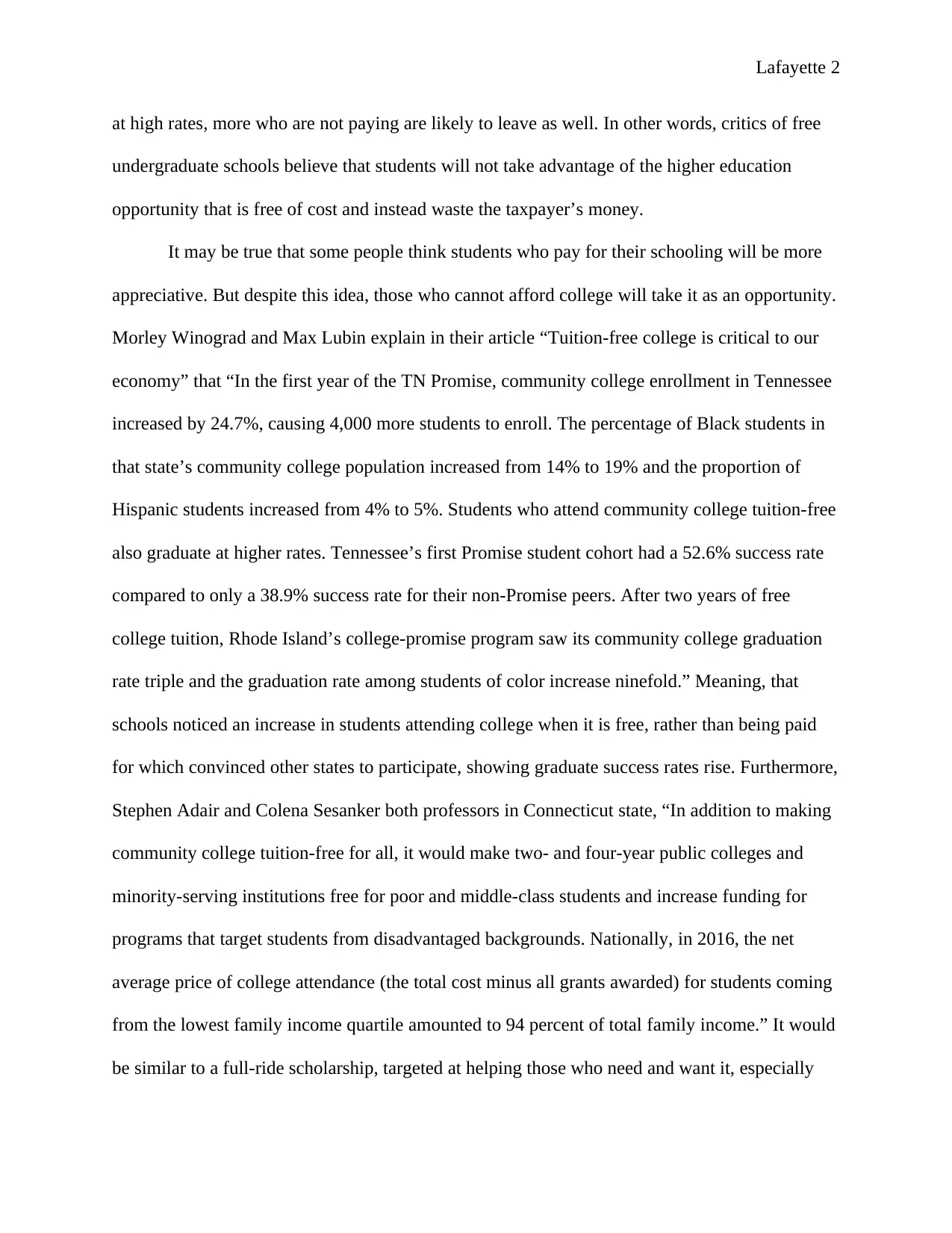
Lafayette 2
at high rates, more who are not paying are likely to leave as well. In other words, critics of free
undergraduate schools believe that students will not take advantage of the higher education
opportunity that is free of cost and instead waste the taxpayer’s money.
It may be true that some people think students who pay for their schooling will be more
appreciative. But despite this idea, those who cannot afford college will take it as an opportunity.
Morley Winograd and Max Lubin explain in their article “Tuition-free college is critical to our
economy” that “In the first year of the TN Promise, community college enrollment in Tennessee
increased by 24.7%, causing 4,000 more students to enroll. The percentage of Black students in
that state’s community college population increased from 14% to 19% and the proportion of
Hispanic students increased from 4% to 5%. Students who attend community college tuition-free
also graduate at higher rates. Tennessee’s first Promise student cohort had a 52.6% success rate
compared to only a 38.9% success rate for their non-Promise peers. After two years of free
college tuition, Rhode Island’s college-promise program saw its community college graduation
rate triple and the graduation rate among students of color increase ninefold.” Meaning, that
schools noticed an increase in students attending college when it is free, rather than being paid
for which convinced other states to participate, showing graduate success rates rise. Furthermore,
Stephen Adair and Colena Sesanker both professors in Connecticut state, “In addition to making
community college tuition-free for all, it would make two- and four-year public colleges and
minority-serving institutions free for poor and middle-class students and increase funding for
programs that target students from disadvantaged backgrounds. Nationally, in 2016, the net
average price of college attendance (the total cost minus all grants awarded) for students coming
from the lowest family income quartile amounted to 94 percent of total family income.” It would
be similar to a full-ride scholarship, targeted at helping those who need and want it, especially
at high rates, more who are not paying are likely to leave as well. In other words, critics of free
undergraduate schools believe that students will not take advantage of the higher education
opportunity that is free of cost and instead waste the taxpayer’s money.
It may be true that some people think students who pay for their schooling will be more
appreciative. But despite this idea, those who cannot afford college will take it as an opportunity.
Morley Winograd and Max Lubin explain in their article “Tuition-free college is critical to our
economy” that “In the first year of the TN Promise, community college enrollment in Tennessee
increased by 24.7%, causing 4,000 more students to enroll. The percentage of Black students in
that state’s community college population increased from 14% to 19% and the proportion of
Hispanic students increased from 4% to 5%. Students who attend community college tuition-free
also graduate at higher rates. Tennessee’s first Promise student cohort had a 52.6% success rate
compared to only a 38.9% success rate for their non-Promise peers. After two years of free
college tuition, Rhode Island’s college-promise program saw its community college graduation
rate triple and the graduation rate among students of color increase ninefold.” Meaning, that
schools noticed an increase in students attending college when it is free, rather than being paid
for which convinced other states to participate, showing graduate success rates rise. Furthermore,
Stephen Adair and Colena Sesanker both professors in Connecticut state, “In addition to making
community college tuition-free for all, it would make two- and four-year public colleges and
minority-serving institutions free for poor and middle-class students and increase funding for
programs that target students from disadvantaged backgrounds. Nationally, in 2016, the net
average price of college attendance (the total cost minus all grants awarded) for students coming
from the lowest family income quartile amounted to 94 percent of total family income.” It would
be similar to a full-ride scholarship, targeted at helping those who need and want it, especially
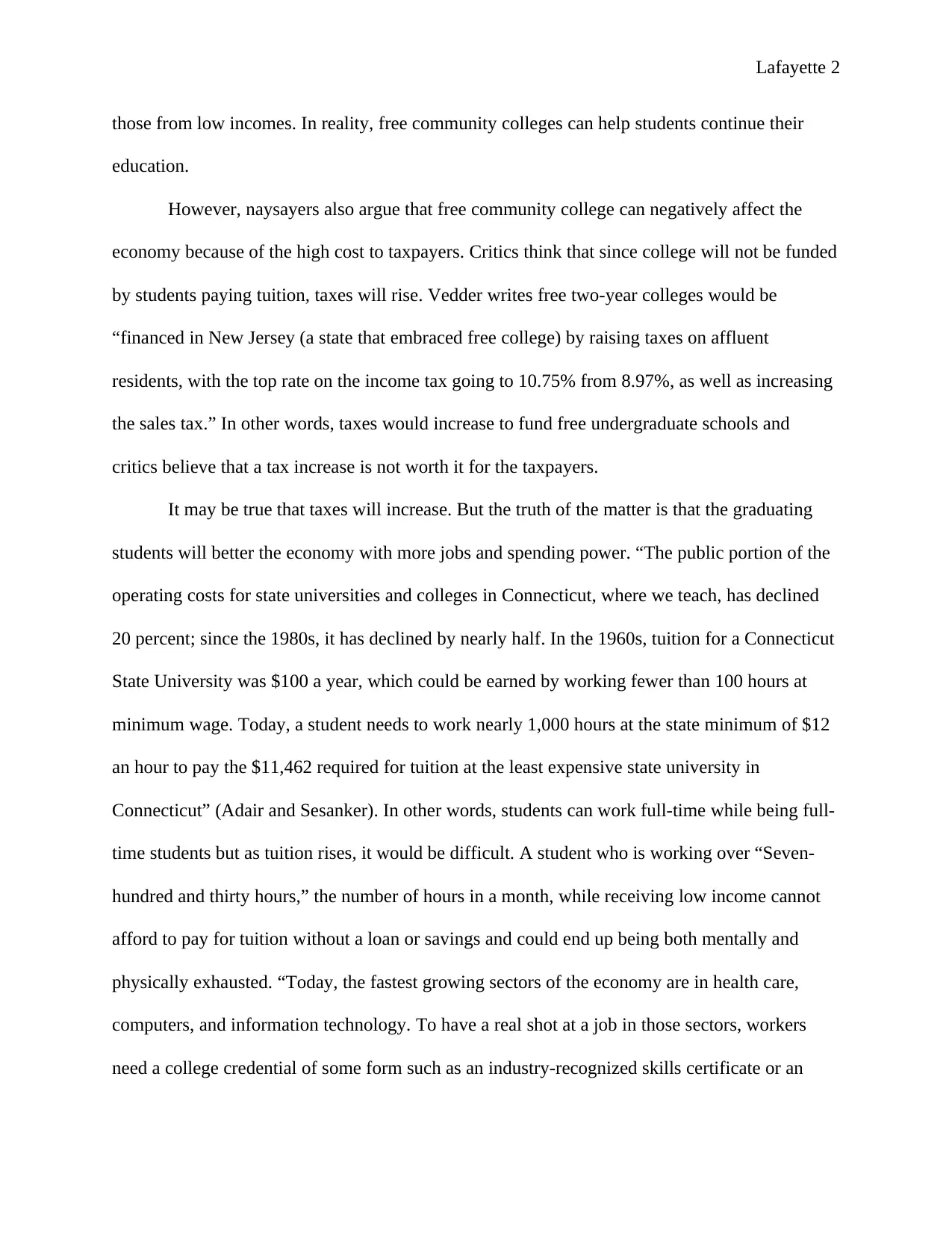
Lafayette 2
those from low incomes. In reality, free community colleges can help students continue their
education.
However, naysayers also argue that free community college can negatively affect the
economy because of the high cost to taxpayers. Critics think that since college will not be funded
by students paying tuition, taxes will rise. Vedder writes free two-year colleges would be
“financed in New Jersey (a state that embraced free college) by raising taxes on affluent
residents, with the top rate on the income tax going to 10.75% from 8.97%, as well as increasing
the sales tax.” In other words, taxes would increase to fund free undergraduate schools and
critics believe that a tax increase is not worth it for the taxpayers.
It may be true that taxes will increase. But the truth of the matter is that the graduating
students will better the economy with more jobs and spending power. “The public portion of the
operating costs for state universities and colleges in Connecticut, where we teach, has declined
20 percent; since the 1980s, it has declined by nearly half. In the 1960s, tuition for a Connecticut
State University was $100 a year, which could be earned by working fewer than 100 hours at
minimum wage. Today, a student needs to work nearly 1,000 hours at the state minimum of $12
an hour to pay the $11,462 required for tuition at the least expensive state university in
Connecticut” (Adair and Sesanker). In other words, students can work full-time while being full-
time students but as tuition rises, it would be difficult. A student who is working over “Seven-
hundred and thirty hours,” the number of hours in a month, while receiving low income cannot
afford to pay for tuition without a loan or savings and could end up being both mentally and
physically exhausted. “Today, the fastest growing sectors of the economy are in health care,
computers, and information technology. To have a real shot at a job in those sectors, workers
need a college credential of some form such as an industry-recognized skills certificate or an
those from low incomes. In reality, free community colleges can help students continue their
education.
However, naysayers also argue that free community college can negatively affect the
economy because of the high cost to taxpayers. Critics think that since college will not be funded
by students paying tuition, taxes will rise. Vedder writes free two-year colleges would be
“financed in New Jersey (a state that embraced free college) by raising taxes on affluent
residents, with the top rate on the income tax going to 10.75% from 8.97%, as well as increasing
the sales tax.” In other words, taxes would increase to fund free undergraduate schools and
critics believe that a tax increase is not worth it for the taxpayers.
It may be true that taxes will increase. But the truth of the matter is that the graduating
students will better the economy with more jobs and spending power. “The public portion of the
operating costs for state universities and colleges in Connecticut, where we teach, has declined
20 percent; since the 1980s, it has declined by nearly half. In the 1960s, tuition for a Connecticut
State University was $100 a year, which could be earned by working fewer than 100 hours at
minimum wage. Today, a student needs to work nearly 1,000 hours at the state minimum of $12
an hour to pay the $11,462 required for tuition at the least expensive state university in
Connecticut” (Adair and Sesanker). In other words, students can work full-time while being full-
time students but as tuition rises, it would be difficult. A student who is working over “Seven-
hundred and thirty hours,” the number of hours in a month, while receiving low income cannot
afford to pay for tuition without a loan or savings and could end up being both mentally and
physically exhausted. “Today, the fastest growing sectors of the economy are in health care,
computers, and information technology. To have a real shot at a job in those sectors, workers
need a college credential of some form such as an industry-recognized skills certificate or an
⊘ This is a preview!⊘
Do you want full access?
Subscribe today to unlock all pages.

Trusted by 1+ million students worldwide
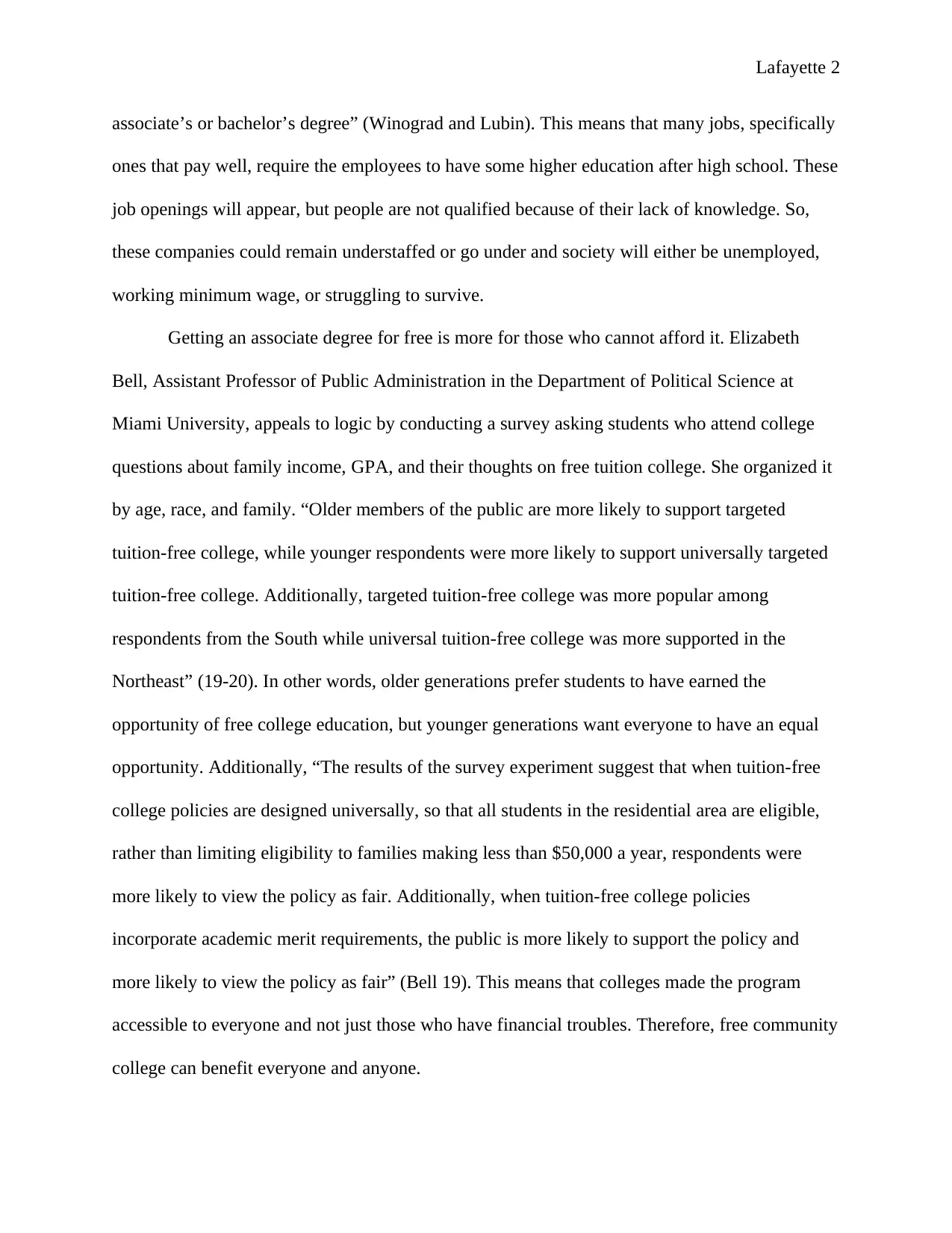
Lafayette 2
associate’s or bachelor’s degree” (Winograd and Lubin). This means that many jobs, specifically
ones that pay well, require the employees to have some higher education after high school. These
job openings will appear, but people are not qualified because of their lack of knowledge. So,
these companies could remain understaffed or go under and society will either be unemployed,
working minimum wage, or struggling to survive.
Getting an associate degree for free is more for those who cannot afford it. Elizabeth
Bell, Assistant Professor of Public Administration in the Department of Political Science at
Miami University, appeals to logic by conducting a survey asking students who attend college
questions about family income, GPA, and their thoughts on free tuition college. She organized it
by age, race, and family. “Older members of the public are more likely to support targeted
tuition-free college, while younger respondents were more likely to support universally targeted
tuition-free college. Additionally, targeted tuition-free college was more popular among
respondents from the South while universal tuition-free college was more supported in the
Northeast” (19-20). In other words, older generations prefer students to have earned the
opportunity of free college education, but younger generations want everyone to have an equal
opportunity. Additionally, “The results of the survey experiment suggest that when tuition-free
college policies are designed universally, so that all students in the residential area are eligible,
rather than limiting eligibility to families making less than $50,000 a year, respondents were
more likely to view the policy as fair. Additionally, when tuition-free college policies
incorporate academic merit requirements, the public is more likely to support the policy and
more likely to view the policy as fair” (Bell 19). This means that colleges made the program
accessible to everyone and not just those who have financial troubles. Therefore, free community
college can benefit everyone and anyone.
associate’s or bachelor’s degree” (Winograd and Lubin). This means that many jobs, specifically
ones that pay well, require the employees to have some higher education after high school. These
job openings will appear, but people are not qualified because of their lack of knowledge. So,
these companies could remain understaffed or go under and society will either be unemployed,
working minimum wage, or struggling to survive.
Getting an associate degree for free is more for those who cannot afford it. Elizabeth
Bell, Assistant Professor of Public Administration in the Department of Political Science at
Miami University, appeals to logic by conducting a survey asking students who attend college
questions about family income, GPA, and their thoughts on free tuition college. She organized it
by age, race, and family. “Older members of the public are more likely to support targeted
tuition-free college, while younger respondents were more likely to support universally targeted
tuition-free college. Additionally, targeted tuition-free college was more popular among
respondents from the South while universal tuition-free college was more supported in the
Northeast” (19-20). In other words, older generations prefer students to have earned the
opportunity of free college education, but younger generations want everyone to have an equal
opportunity. Additionally, “The results of the survey experiment suggest that when tuition-free
college policies are designed universally, so that all students in the residential area are eligible,
rather than limiting eligibility to families making less than $50,000 a year, respondents were
more likely to view the policy as fair. Additionally, when tuition-free college policies
incorporate academic merit requirements, the public is more likely to support the policy and
more likely to view the policy as fair” (Bell 19). This means that colleges made the program
accessible to everyone and not just those who have financial troubles. Therefore, free community
college can benefit everyone and anyone.
Paraphrase This Document
Need a fresh take? Get an instant paraphrase of this document with our AI Paraphraser
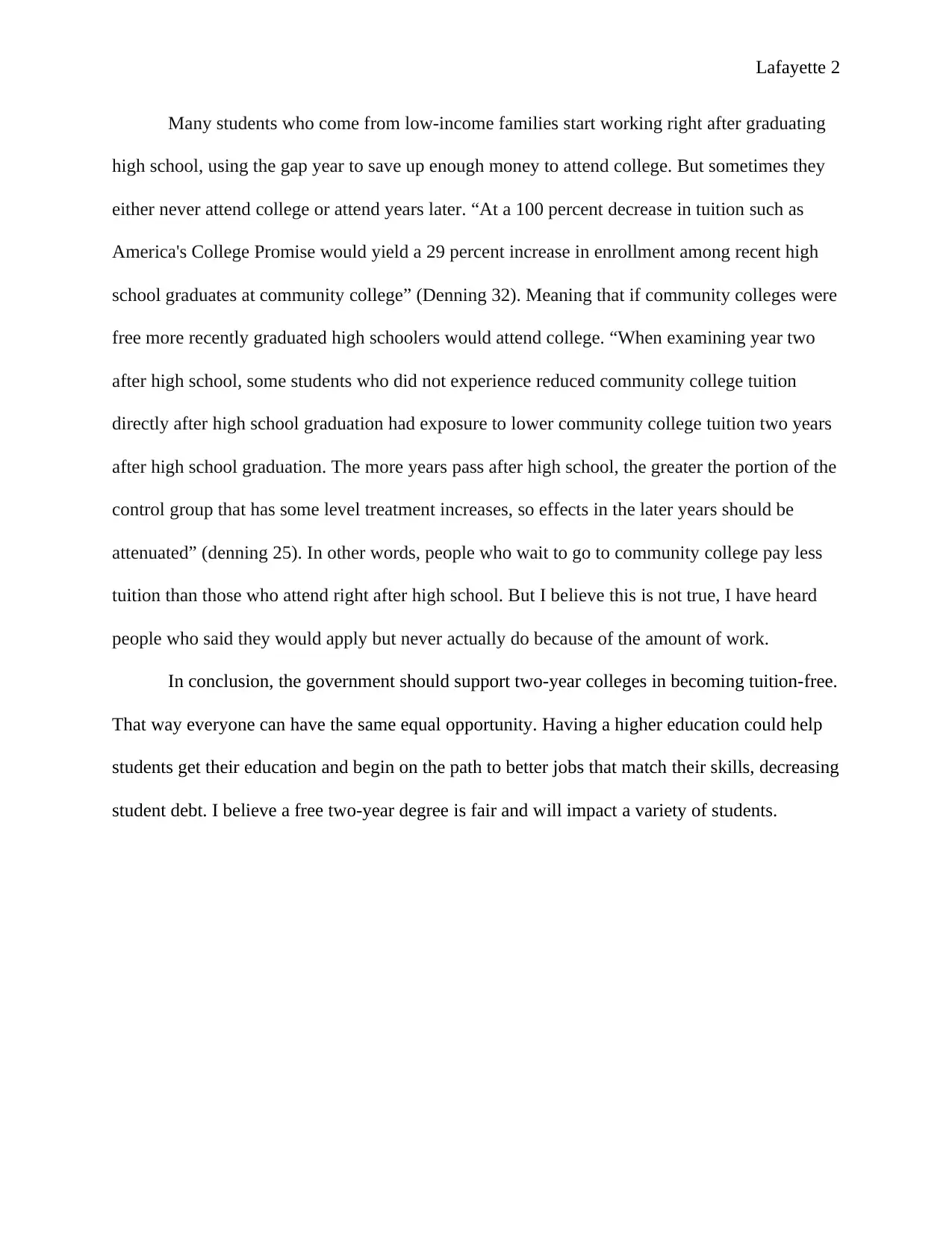
Lafayette 2
Many students who come from low-income families start working right after graduating
high school, using the gap year to save up enough money to attend college. But sometimes they
either never attend college or attend years later. “At a 100 percent decrease in tuition such as
America's College Promise would yield a 29 percent increase in enrollment among recent high
school graduates at community college” (Denning 32). Meaning that if community colleges were
free more recently graduated high schoolers would attend college. “When examining year two
after high school, some students who did not experience reduced community college tuition
directly after high school graduation had exposure to lower community college tuition two years
after high school graduation. The more years pass after high school, the greater the portion of the
control group that has some level treatment increases, so effects in the later years should be
attenuated” (denning 25). In other words, people who wait to go to community college pay less
tuition than those who attend right after high school. But I believe this is not true, I have heard
people who said they would apply but never actually do because of the amount of work.
In conclusion, the government should support two-year colleges in becoming tuition-free.
That way everyone can have the same equal opportunity. Having a higher education could help
students get their education and begin on the path to better jobs that match their skills, decreasing
student debt. I believe a free two-year degree is fair and will impact a variety of students.
Many students who come from low-income families start working right after graduating
high school, using the gap year to save up enough money to attend college. But sometimes they
either never attend college or attend years later. “At a 100 percent decrease in tuition such as
America's College Promise would yield a 29 percent increase in enrollment among recent high
school graduates at community college” (Denning 32). Meaning that if community colleges were
free more recently graduated high schoolers would attend college. “When examining year two
after high school, some students who did not experience reduced community college tuition
directly after high school graduation had exposure to lower community college tuition two years
after high school graduation. The more years pass after high school, the greater the portion of the
control group that has some level treatment increases, so effects in the later years should be
attenuated” (denning 25). In other words, people who wait to go to community college pay less
tuition than those who attend right after high school. But I believe this is not true, I have heard
people who said they would apply but never actually do because of the amount of work.
In conclusion, the government should support two-year colleges in becoming tuition-free.
That way everyone can have the same equal opportunity. Having a higher education could help
students get their education and begin on the path to better jobs that match their skills, decreasing
student debt. I believe a free two-year degree is fair and will impact a variety of students.
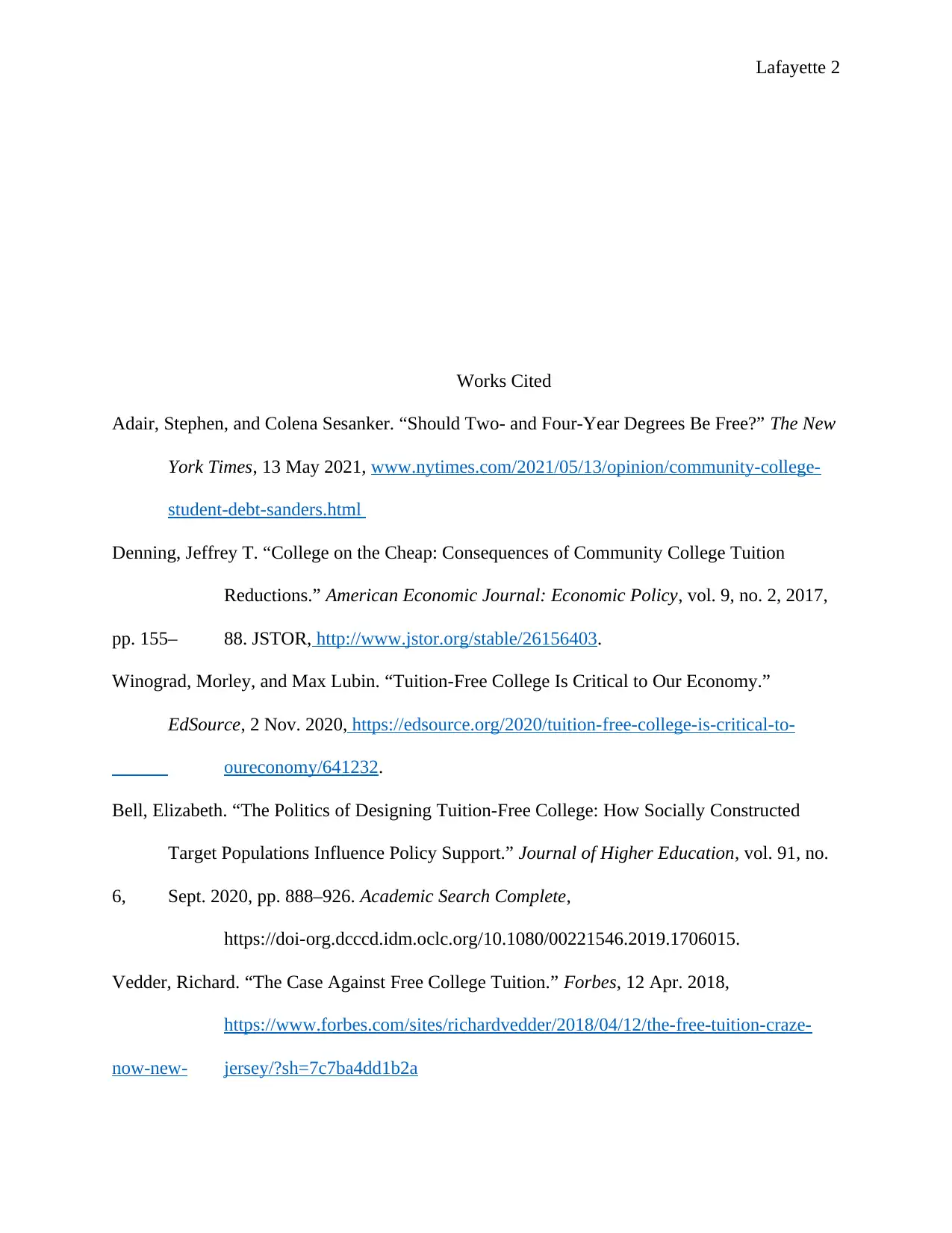
Lafayette 2
Works Cited
Adair, Stephen, and Colena Sesanker. “Should Two- and Four-Year Degrees Be Free?” The New
York Times, 13 May 2021, www.nytimes.com/2021/05/13/opinion/community-college-
student-debt-sanders.html
Denning, Jeffrey T. “College on the Cheap: Consequences of Community College Tuition
Reductions.” American Economic Journal: Economic Policy, vol. 9, no. 2, 2017,
pp. 155– 88. JSTOR, http://www.jstor.org/stable/26156403.
Winograd, Morley, and Max Lubin. “Tuition-Free College Is Critical to Our Economy.”
EdSource, 2 Nov. 2020, https://edsource.org/2020/tuition-free-college-is-critical-to-
oureconomy/641232.
Bell, Elizabeth. “The Politics of Designing Tuition-Free College: How Socially Constructed
Target Populations Influence Policy Support.” Journal of Higher Education, vol. 91, no.
6, Sept. 2020, pp. 888–926. Academic Search Complete,
https://doi-org.dcccd.idm.oclc.org/10.1080/00221546.2019.1706015.
Vedder, Richard. “The Case Against Free College Tuition.” Forbes, 12 Apr. 2018,
https://www.forbes.com/sites/richardvedder/2018/04/12/the-free-tuition-craze-
now-new- jersey/?sh=7c7ba4dd1b2a
Works Cited
Adair, Stephen, and Colena Sesanker. “Should Two- and Four-Year Degrees Be Free?” The New
York Times, 13 May 2021, www.nytimes.com/2021/05/13/opinion/community-college-
student-debt-sanders.html
Denning, Jeffrey T. “College on the Cheap: Consequences of Community College Tuition
Reductions.” American Economic Journal: Economic Policy, vol. 9, no. 2, 2017,
pp. 155– 88. JSTOR, http://www.jstor.org/stable/26156403.
Winograd, Morley, and Max Lubin. “Tuition-Free College Is Critical to Our Economy.”
EdSource, 2 Nov. 2020, https://edsource.org/2020/tuition-free-college-is-critical-to-
oureconomy/641232.
Bell, Elizabeth. “The Politics of Designing Tuition-Free College: How Socially Constructed
Target Populations Influence Policy Support.” Journal of Higher Education, vol. 91, no.
6, Sept. 2020, pp. 888–926. Academic Search Complete,
https://doi-org.dcccd.idm.oclc.org/10.1080/00221546.2019.1706015.
Vedder, Richard. “The Case Against Free College Tuition.” Forbes, 12 Apr. 2018,
https://www.forbes.com/sites/richardvedder/2018/04/12/the-free-tuition-craze-
now-new- jersey/?sh=7c7ba4dd1b2a
⊘ This is a preview!⊘
Do you want full access?
Subscribe today to unlock all pages.

Trusted by 1+ million students worldwide

Lafayette 2
Billings, Meredith. “Understanding the Design of College Promise Programs, and Where to Go
From Here.” Brookings, 18 Sept. 2018, www.brookings.edu/blog/brown-center-
chalkboard/2018/09/18/understanding-the-design-of-college-promise-programs-and-
where- to-go-from-here.
Billings, Meredith. “Understanding the Design of College Promise Programs, and Where to Go
From Here.” Brookings, 18 Sept. 2018, www.brookings.edu/blog/brown-center-
chalkboard/2018/09/18/understanding-the-design-of-college-promise-programs-and-
where- to-go-from-here.
1 out of 7
Related Documents
Your All-in-One AI-Powered Toolkit for Academic Success.
+13062052269
info@desklib.com
Available 24*7 on WhatsApp / Email
![[object Object]](/_next/static/media/star-bottom.7253800d.svg)
Unlock your academic potential
Copyright © 2020–2025 A2Z Services. All Rights Reserved. Developed and managed by ZUCOL.





